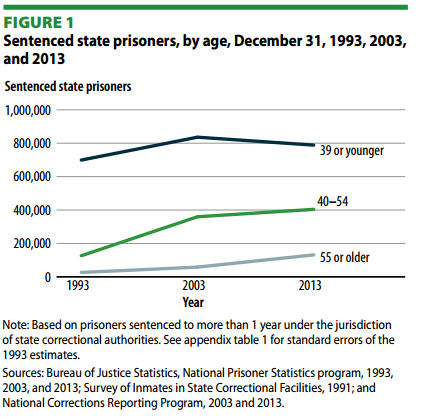Introduction
The problem of prison overcrowding not only remains on the U.S. agenda but also grows gradually. According to a recent report published by the Bureau of Justice Statistics (2013), the state prison aging rates have been on the rise since 1993 (see Appendix A) (Bureau of Justice Statistics, 2013). Therefore, there is an urgent need to consider the adoption of the strategies that will help reduce the overcrowding rates so that the threats associated with the phenomenon (including health concerns (Roux-Kemp, 2013)) could be avoided successfully.
The Policy That Might Help: Determining the Necessary Course of Actions
Legislative Issues
At present, many drug addicts are sentenced to long-term imprisonment, which leads to overcrowding. Therefore, the current law needs to focus on providing assistance to drug addicts and helping them to rehabilitate instead of imprisoning them. Petty criminals are also affected greatly by the Three Strikes Law (TSL) (MacDonald, 2013), which deprives them of an opportunity to mend their ways. Thus, the TSL must be reconsidered.
It would be wrong to believe that a refusal for TSL completely is a reasonable step to make. Instead, the principles according to which it should be applied to legal cases need to be reconsidered. For instance, the applicability of the regulation toward the people responsible for committing petty crimes could be revisited.
Executive Issues
How the legal requirements are executed also leaves much to be desired. Although several projects aimed at reducing the prison overcrowding rates exist, they lack consistency. For example, pretrial detention is considered among the key ways of improving the current state of affairs from an executive point of view. However, the identified tool does not help fight the issues that lie at the core of the problem, but, instead, tends to embrace only what lies on the surface (Wheeler, 2011). Instead of considering other opportunities for detention, more complex and comprehensive approaches such as the use of restorative justice practices should be considered.
Judicial Issues
Eventually, the judicial aspect of policing must be studied. For example, police as the judicial institution should adopt a more appropriate strategy for managing cases. Sentencing guidelines need to be reconsidered so that the process of determining whether the Three Strikes regulation applies to a particular issue could become easier (Stein, 2012).
Social Justice
The changes mentioned above, however, will not have a positive effect unless the members of society recognize the need to shape the current regulations. For instance, as long as drug addicts are viewed as not people with health issues but an immediate threat, the changes to the current policies are unlikely to lead to positive outcomes. Therefore, there is an urge to make a societal change to promote the one on other levels.
Conclusion
Since overcrowding in prisons leads to a range of health concerns in jail and prevents from enhancing the effects of drug rehabilitation prison programs there is a need to address the issue on all three policing levels, i.e., the legislative, the executive, and the judicial ones. For instance, in managing the drug abuse problem, one should put a stronger emphasis on rehabilitation instead of punishment, thus, drawing a line between substance addicts and drug peddlers. Furthermore, it will be necessary to take steps to reconsider the Three Strikes Law, which currently affects minor offenders to a considerable extent. Finally, the issue of detention needs to be revisited as it also affects the number of prison inmates significantly.
References
Bureau of Justice Statistics. (2013). Aging of the state prison population, 1993–2013. Web.
MacDonald, M. (2013). Reducing California ‘s overcrowded prison population. Themis: Research Journal of Justice Studies and Forensic Science, 1(1), 7-14.
Roux-Kemp, A. D. (2013). Overcrowding in prisons: A health risk in need of (re)consideration. Health Law Review, 21(2), 33-38.
Stein, A. (2012). Back on the Chain Gang: The New/Old Prison Labor Paradigm. Journal of Psychohistory, 39(4), 254-260.
Wheeler, C. N. (2011). Overcrowded and understaffed, Illinois prisons are in crisis. Illinois Issues, 37(11), 37.
Appendix A: Prison Aging rates (1993-2013) (Bureau of Justice Statistics, 2013)
